- News
- Reviews
- Bikes
- Components
- Bar tape & grips
- Bottom brackets
- Brake & gear cables
- Brake & STI levers
- Brake pads & spares
- Brakes
- Cassettes & freewheels
- Chains
- Chainsets & chainrings
- Derailleurs - front
- Derailleurs - rear
- Forks
- Gear levers & shifters
- Groupsets
- Handlebars & extensions
- Headsets
- Hubs
- Inner tubes
- Pedals
- Quick releases & skewers
- Saddles
- Seatposts
- Stems
- Wheels
- Tyres
- Tubeless valves
- Accessories
- Accessories - misc
- Computer mounts
- Bags
- Bar ends
- Bike bags & cases
- Bottle cages
- Bottles
- Cameras
- Car racks
- Child seats
- Computers
- Glasses
- GPS units
- Helmets
- Lights - front
- Lights - rear
- Lights - sets
- Locks
- Mirrors
- Mudguards
- Racks
- Pumps & CO2 inflators
- Puncture kits
- Reflectives
- Smart watches
- Stands and racks
- Trailers
- Clothing
- Health, fitness and nutrition
- Tools and workshop
- Miscellaneous
- Buyers Guides
- Features
- Forum
- Recommends
- Podcast
review
£2,149.99
VERDICT:
Lightweight aero bike; uncompromisingly fast, firm ride limits its appeal for longer excursions
Weight:
7,800g
Contact:
At road.cc every product is thoroughly tested for as long as it takes to get a proper insight into how well it works. Our reviewers are experienced cyclists that we trust to be objective. While we strive to ensure that opinions expressed are backed up by facts, reviews are by their nature an informed opinion, not a definitive verdict. We don't intentionally try to break anything (except locks) but we do try to look for weak points in any design. The overall score is not just an average of the other scores: it reflects both a product's function and value – with value determined by how a product compares with items of similar spec, quality, and price.
What the road.cc scores meanGood scores are more common than bad, because fortunately good products are more common than bad.
- Exceptional
- Excellent
- Very Good
- Good
- Quite good
- Average
- Not so good
- Poor
- Bad
- Appalling
Dedacciai's Atleta is a fast and uncompromising frameset that's light and quick. If you're happy with the aggressive position and the firm ride then you'll enjoy racing it, and racing, especially crits, is probably what it's best suited for. This 11-speed Campag Athena build is light enough to be ready to race but it's also good, dependable kit.
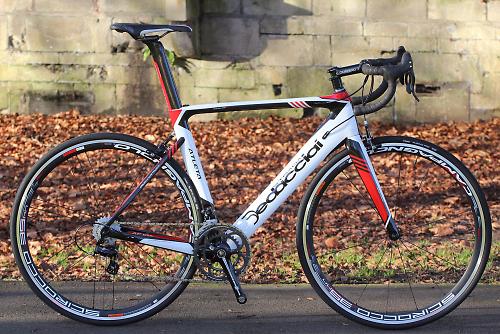
At 980g for a medium frame the Atleta ranks as a proper lightweight, and especially so for an aero frameset where the larger tube profiles generally mean a heavier bike. Though the down tube is a massive unit other parts of the frame are more slender, especially the shaped top tube and the seatstays, which are positioned lower for an aero advantage and are also sculpted and thinned to offer a bit of compliance.
Dedacciai claim that the slippery Atleta is 15% less of a drag than a standard round-tubed bike. The light weight is in part thanks to two processes. Dedacciai use a proprietary epoxy resin which they claim is better able to fill the microscopic spaces between the fibres, so they don't need as much. The Atleta also uses an anti-wrinkle process to keep the internal surfaces of the frame smooth and save some weight.
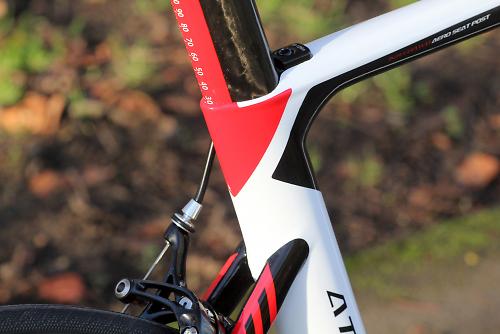
Up front there's an tapered head tube (1 1/8in - 1 1/2in) to keep things stiff and in it sits a 370g carbon monocoque fork. The head tube is short (155mm on our large frame) and the position aggressive; I needed to run plenty of the aero-section seatpost. The seatpost clamp is recessed into the frame in front of the seatpost and Dedacciai suggest 10Nm of torque to keep it in place, which feels like a lot to be putting through the structure of the frame and 'post.
We had some issues with the original seatpost slipping, and Dedacciai sent out a replacement clamp and seatpost, both with a grippier surface. That, and a sachet of anti-slip compound, solved the problem. If you're looking to buy an Atleta, best to make sure it's one with the new seatpost rather than the old one, which is a gloss finish with position markers.
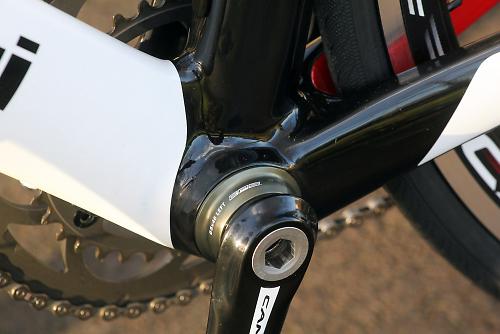
The frame is internally routed and drilled for both mechanical and electronic groupsets, with a change of mounting hardware required to swap between the two. Our bike was built up with Campagnolo's entry-level 11-speed groupset, Athena. Wheels are also by Campagnolo, Scirocco 35 alloys with Vittoria Rubino tyres.
Deda's own alloy bar and stem and a Selle Italia Flow X1 saddle finish off the build. That gives an all-in weight of 7.8kg; it'd be fairly straightforward to build the frame up to the UCI weight limit with standard (albeit more expensive) kit.

Out on the road the Atleta is uncompromising in its desire to go fast. Certainly if you're looking for a bump-smoothing endurance bike you're looking in the wrong place here. The ride is very firm and direct, with the power transfer through the bottom bracket and deep-section chainstays efficient and flex-free. The bottom bracket is a 68mm PF30 rather than something wider but there's no discernible penalty for that. Stamp on the pedals and it's all forward motion, even when you're in a full-on sprint.
Up front it's the same story, there's lots of directness in the steering and it's nice and quick with no hint of vagueness when you're descending at speed. There's a touch of flex along the top of the frame when you're shifting your weight around, but nothing that really detracts from the handling of the bike.
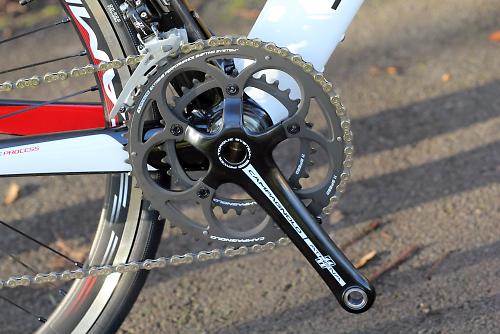
Like many aero bikes the Atleta feels most at home going quickly. The Scirocco wheels aren't the fastest to spin up but when you're up to 25mph the bike feels like it's at the speed it's designed for. On smoother surfaces the Atleta really flies along, although on rougher surfaces the lack of damping does rob you of a bit of speed.
I was most at home on the bike racing it on the billiard-table-smooth tarmac of the Odd Down circuit where it felt just the ticket for bunch riding at speed. I managed to slide out on a corner riding the Atleta but that was more down to the rather average grip of the Rubino tyres and my own hubris than any inherent handling flaw. I swapped the tyres out for Zipp Tangente Speeds, which improved the feel of the bike a bit, and the levels of grip a lot.

I also took the Atleta on the chaingang and the fast, aggressive position made it ideal for that too, although that was before the seatpost swap so I did have to stop and raise the saddle before the end. The chaingang is mostly well-sufaced roads as well; it's fair so say that on other, longer rides on the bike on lower quality surfaces the firm ride has started to make itself felt, especially in the hands and arms. If you're looking for a bike for smashing out two-hour training rides and races it's fine, but if you want the perfect bike for a six-hour sportive round the lanes it'll be further down the list.
The Campag Athena groupset performed very well throughout testing. It took a short while to get the rear shifting dialled in but once it was there it barely missed a beat. The Athena shifters now have a (one shift at a time) downshift paddle that's redolent of the EPS one, although still slightly higher as the mechanics demand. It's easier to reach from the drops now than previous incarnations, and I had no issues accessing either shift from the drops, although I do have big hands.
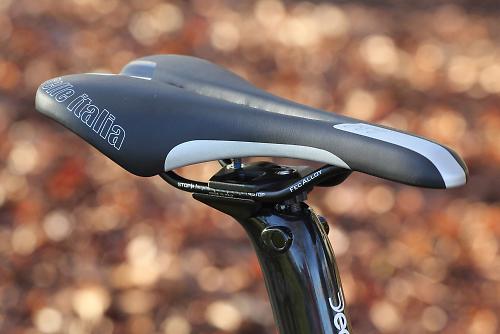
At £2,149 for the Athena build the Atleta represents decent if not exceptional value for money. The frameset will cost you £1,349 on its own, and with an Athena groupset going for around £400-£500, and £170 for the wheels, you'd just about save a few quid building the bike up yourself, but it's not like other bikes from smaller manufacturers we've seen where the build price is hundreds of pounds more than the DIY option. The self-build option is still an attractive one though, with groupsets being discounted so heavily, so it's good to have the option to buy frame-only.
Is the Atleta the bike for you? Maybe, if you're looking for something fast and aggressive. It's a capable racer with good handling and it certainly gives you plenty of feedback. The firm ride can make the bike feel a bit monolithic at times, and you'll start to feel it on long rides, but if you're looking for a bike for short, fast blasts then it's certainly one to consider. If you're not a fan of the rather brash paint scheme of this frame then there's a stealthy black option available too. An Ultegra build is available for £2,324.99.

Verdict
Lightweight aero bike; uncompromisingly fast, firm ride limits its appeal for longer excursions
road.cc test report
Make and model: Dedacciai Atleta
Size tested: 59
About the bike
State the frame and fork material and method of construction. List the components used to build up the bike.
Tech specs:
Sizes: XS (51.8), S (54), M (56), L (58.1), XL (60.5)
Electronic and mechanical devices compatible
Monocoque full carbon fork 1"1/8 1"1/2
Integrated Dedacciai headset SSDIFFincluded
Tapered headtube 1"1/8 top 1"1/2 bottom
Bottom bracket: BSA compatible
Internal cable routing
Seat Tube ID: 34,9mm
UD external layer
Frame weight: 980g (M)
Fork weight: 370g
Bike Spec:
Group: Campagnolo Athena/Miche
Wheel: Campagnolo Scirrocco 35s
Tyres: Vittoria Rubino
Saddle: Selle Italia X1 Flow
Handlebar: RHM01
Seatpost: Adjustable aero, 235 g, with micro off-set adjustment
Bar tape: Deda
Stem: Zero1
Tell us what the bike is for, and who it's aimed at. What do the manufacturers say about it? How does that compare to your own feelings about the bike?
Muscled with an aero shape profile it is well suitable for flat stages and for the combative sprints, gritty and unfailing it is superior in the longest uphill and descents.
ATLETA is the total combination of the best Japanese carbon fiber produced by Toray with the crucial carbon fiber lay-up disposition in order to get light and reliable carbon tubes. These technologies allow to produce a superior frame kit furthermore it is able to provide the best driving sensations, rigidity and harmony with the rider, mostly in the tough stages when the pedal action becomes hard and tied. The areas of maximum stress: the bottom bracket, head tube and seat tube are all strengthened in order to maintain a high degree of stiffness whilst retaining the parallel alignment of the wheel axes during the pedal stroke.
The Dedacciai frame building process is called Nano Technology. The Dedacciai manufacturing technology is based upon a special epoxy resin which is able to fill the microscopic spaces between carbon fibers and the molecules in order to bond the fibers to each other with a longer life for the frame. That process allows production of a fiber and resin Prepreg composite which has better qualities compared to ordinary Prepreg. Less carbon fibers, reducing total frame weight, and high torsion ratio are the main features of Nano Technology.
The Atleta frame kit has been engineered and studied with fluid-dynamic test in order to obtain the best air penetration aerodynamic ratio. The shapes of head tube, down tube and seat tube allow 15% save of air resistance respect to the common round tube shape. Furthermore the seat post clamp has been putted inside the top tube in order to obtain the best aerodynamic performance. We suggest to use a torque wrench to fix the seat clamp at 10 Nm.
ATLETA is equipped with the PF 30 (press fit 30) with bottom bracket length of 68 mm. Dedacciai offers BB30 and BSA adaptors as spare parts. The PF30 (press Fit 30) standard has the classical bearings insertion BB30 (42 mm) in the Bottom bracket within pressure plastic caps. The central bottom bracket has an ID of 46 mm. The PF 30 adopts a bottom bracket with a bigger inner diameter compared to those available in the market.
The frame kit ATLETA is also equipped with a monocoque carbon fork with tapered steering tube of 1'1/8 top and 1'1/2 bottom in order to grant an higher reliability standard on every kind of surface.
Atleta is fully compatible with mechanical and electronic shifting systems running the cables inside the down tube and in the chain stays, via an internal carbon bottom bracket passage. The refined attention to details could be seen in the routing of the rear derailleur wire through the alloy rear dropout. The frame is also compatible with cable-operated shifting systems. That double compatibility is obtained by replacing small parts through the 'cable stopper' system described above.
Frame and fork
Overall rating for frame and fork
8/10
Tell us about the build quality and finish of the frame and fork?
Nicely made with a high quality finish.
Tell us about the materials used in the frame and fork?
Monocoque Toray carbon
Tell us about the geometry of the frame and fork?
Large: 575mm effective top tube, 155mm head tube, 72.5° seat tube, 73° head tube
How was the bike in terms of height and reach? How did it compare to other bikes of the same stated size?
It's an aggressive position.
Riding the bike
Was the bike comfortable to ride? Tell us how you felt about the ride quality.
The ride is pretty firm, better over shorter distances and smoother surfaces.
Did the bike feel stiff in the right places? Did any part of the bike feel too stiff or too flexible?
It's plenty stiff.
How did the bike transfer power? Did it feel efficient?
Power transfer is excellent.
Was there any toe-clip overlap with the front wheel? If so, was it a problem?
No issues.
How would you describe the steering? Was it lively, neutral or unresponsive? Neutral to lively.
Tell us some more about the handling. How did the bike feel overall? Did it do particular things well or badly?
Steering is direct and precise.
Rate the bike for efficiency of power transfer:
9/10
Rate the bike for acceleration:
8/10
Rate the bike for sprinting:
8/10
Rate the bike for high speed stability:
8/10
Rate the bike for cruising speed stability:
8/10
Rate the bike for low speed stability:
7/10
Rate the bike for flat cornering:
8/10
Rate the bike for cornering on descents:
8/10
Rate the bike for climbing:
7/10
The drivetrain
Rate the drivetrain for performance:
8/10
Rate the drivetrain for durability:
8/10
Rate the drivetrain for weight:
7/10
Rate the drivetrain for value:
7/10
Wheels and tyres
Rate the wheels and tyres for performance:
7/10
Rate the wheels and tyres for durability:
8/10
Rate the wheels and tyres for weight:
6/10
Rate the wheels and tyres for comfort:
6/10
Rate the wheels and tyres for value:
7/10
Controls
Rate the controls for performance:
7/10
Rate the controls for durability:
8/10
Rate the controls for weight:
7/10
Rate the controls for comfort:
6/10
Rate the controls for value:
7/10
Your summary
Did you enjoy riding the bike? Yes, especially on shorter rides.
Would you consider buying the bike? Maybe for racing.
Would you recommend the bike to a friend? Depending on their needs, yes.
Rate the bike overall for performance:
7/10
Rate the bike overall for value:
6/10
About the tester
Age: 42 Height: 189cm Weight: 91kg
I usually ride: whatever I'm testing... My best bike is: Kinesis Tripster ATR
I've been riding for: Over 20 years I ride: Every day I would class myself as: Experienced
I regularly do the following types of riding: road racing, commuting, club rides, sportives, general fitness riding, fixed/singlespeed, mtb, Mountain Bike Bog Snorkelling, track
Dave is a founding father of road.cc, having previously worked on Cycling Plus and What Mountain Bike magazines back in the day. He also writes about e-bikes for our sister publication ebiketips. He's won three mountain bike bog snorkelling World Championships, and races at the back of the third cats.
Latest Comments
- snooks 35 min 23 sec ago
I'm not a Lance fan at all but the snarky tone of this is just dumb.
- Paul J 43 min 48 sec ago
Is it just me or is there a link or embed missing for the image of the Dublin bike lane from Ola Løkken Nordrum?
- BikingBud 1 hour 32 min ago
How can anybody reject the beauty of that? It's a wonderful mix of modern tech yet absolutely functional.
- amawby 2 hours 40 min ago
Not unless theVED is made eye wateringly expensive....
- mdavidford 2 hours 51 min ago
My mum always told me I'd inherited her 'hobbit feet', though as far as I'm aware we don't have any family in New Zealand.
- andystow 3 hours 8 min ago
Hyponatremia is a real risk even for an amateur cyclist or runner in hot weather. I've bonked from it before, and I was drinking Gatorade the whole...
- wtjs 3 hours 50 min ago
in the UK we have policing which to a greater or lesser extent relies on assistance from members of the public......
- Cadcam 4 hours 54 min ago
Just wanted to share a quick thank you to everyone who helped out in this thread....
- SecretSam 5 hours 8 min ago
So...don't cycle on it. Lots of other routes around that area. Source: I used to work there.
- Steve K 5 hours 28 min ago
My photochromic specs have just turned up in the post today































Add new comment
1 comments
Hmmm this is on the next bike list - wondering how it stacks up against the new Canyon Aeroad!